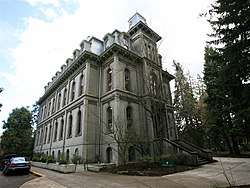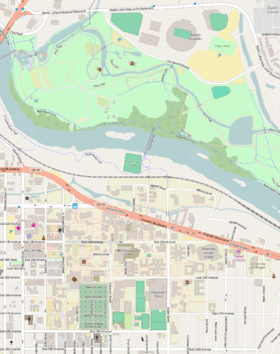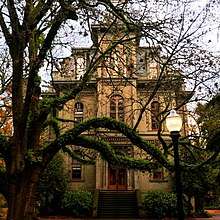Deady Hall
University Hall, formerly Deady Hall is a historic building located in Eugene, Oregon, United States. It was built from 1873 to 1876[2] by W. H. Abrams[3] to a design by architect William W. Piper.[2] It was the University of Oregon's first building, and remained the university's only building for almost ten years after its construction. After the university gained other buildings, it was known simply as the "Old Building", but in 1893 it was renamed "Deady Hall" in honor of Matthew Deady, Oregon's first federal judge. Ironically, Deady believed that state universities were of little use to anybody, and in 1857, during the Oregon Constitutional Convention, Deady moved to strike the section authorizing a university from the Oregon State Constitution. His efforts were initially successful, although by the 1870s a state university had become inevitable, and the building that bears his name was constructed in spite of Deady's earlier objections. In another twist of fate, Deady was first president of the university's Board of Regents.[4]
University Hall, formerly Deady Hall | |
 | |
 | |
| Location | Eugene, Oregon |
|---|---|
| Coordinates | 44.04667°N 123.07643°W |
| Area | 1 acre (0.40 ha) |
| Built | 1873-1876 |
| Architectural style | Italianate |
| NRHP reference No. | 72001082[1] |
| Added to NRHP | April 11, 1972 |

Deady Hall is variously described as simplified Italianate with Second Empire details or simply as Second Empire (though not as elaborate an example as Villard Hall).
This building was listed on National Register of Historic Places in 1972.[1][3] It and nearby Villard Hall were together designated as one National Historic Landmark in 1977.[3][5][6]
At the Oregon Constitutional Convention in 1857, Matthew Deady had advocated for discrimination towards African-Americans, who were not allowed to settle in the new state.[7][8] Because of these views, Deady Hall has been the target of a renaming effort.[9] On June 10, 2020, UO President Michael Schill sent a letter to the Board of Trustees recommending denaming Deady Hall because of Deady's racist views. On June 24, 2020, the University of Oregon's Board of Trustees announced that the name "Deady" would be removed as the name of the Hall until a date when a new name can be chosen. In the interim, the Hall will be named "University Hall." [10]
References
- "National Register Information System". National Register of Historic Places. National Park Service. July 9, 2010.
- UO Libraries. "UO's Architectural Timelines: 19th century". University of Oregon. Retrieved 20 July 2013.
- UO Libraries. "The Architecture of the University of Oregon: Deady Hall". University of Oregon. Retrieved 20 July 2013.
- Force, Rebecca (2001), "Gambling on Higher Education: A History of the Founding of the University of Oregon", Oregon Historical Quarterly, 102 No. 4 (Winter 2001): 500–508, JSTOR 20615186
- "Deady and Villard Halls, University of Oregon". National Historic Landmark summary listing. National Park Service. Archived from the original on 2008-04-30. Retrieved 2008-07-05.
- Carolyn Pitts (1977-02-17). "National Register of Historic Places Inventory-Nomination: Deady and Villard Halls, University of Oregon" (pdf). National Park Service. Cite journal requires
|journal=(help) and Accompanying nine images, from 1876 and undated - Flores, Trudy and Sarah Griffith. The Oregon History Project: U.S. District Judge Matthew Deady. Oregon Historical Society. Retrieved on June 20, 2016.
- Leeson, Fred. (1998). Rose City Justice: A Legal History of Portland, Oregon. Oregon Historical Society Press. pp. 13-15, 21-26, 47-48, 52.
- Johnson, David Alan; Taylor, Quintard; Weisiger, Marsha. "Report on the History of Matthew P. Deady and Frederick S. Dunn" (PDF). University of Oregon. Retrieved 10 September 2016.
- Schill, Michael (June 10, 2020). "Letter to University of Oregon Board of Trustees, re:RThe Denaming of Deady Hall" (PDF). president.uoregon.edu. Retrieved June 14, 2020.
